Flir BelgiumBA MTX2 Light Marine Radar User Manual Owners Handbook
Raymarine UK Ltd. Light Marine Radar Owners Handbook
Owners Handbook

Pathfinder
Radar
Scanners
owner’s
handbook
Document number: 81154_1
Date: 23rd December 1998
154_1cvr.p65 24/12/98, 08:541

Pathfinder Radar Scanners
154_1cvr.p65 24/12/98, 08:542

Pathfinder Radar Scanners
Owners Handbook
December 1998
SAFETY NOTICES
This radar equipment must be installed and operated in accordance with the
instructions contained in this manual. Failure to do so can result in personal
injury and/or navigational inaccuracies. In particular:
1. HIGH VOLTAGE. The scanner unit contain high voltages. Adjustments
require specialised service procedures and tools only available to qualified
service technicians – there are no user serviceable parts or adjustments. The
operator should never remove the scanner unit cover or attempt to service the
equipment.
2. ELECTROMAGNETIC ENERGY. The radar scanner transmits
electromagnetic energy. It is important that the radar is turned off whenever
personnel are required to come close to the scanner to perform work on the
scanner assembly or associated equipment.
It is recommended that the radar scanner is mounted out of range of personnel
(above head height).
Avoid looking directly at the antenna as your eyes are the most sensitive part of
the body to electromagnetic energy.
When properly installed and operated, the use of this radar will conform to the
requirements of ANSI/IEEE C95.1-1992 Standard for Safety Levels with
Respect to Human Exposure to Radio Frequency Electromagnetic Fields, 3Hz
to 300 GHz.
3. NAVIGATION AID. This radar unit is only an aid to navigation. Its
accuracy can be affected by many factors, including equipment failure or
defects, environmental conditions, and improper handling or use. It is the user’s
responsibility to exercise common prudence and navigational judgements.
This radar unit should not be relied upon as a substitute for such prudence and
judgement.
154_1saf.p65 24/12/98, 08:541

Pathfinder Radar Scanners
RAYTHEON MARINE products are supported by a network of Authorized
Service Representatives. For information on Raytheon products and services,
contact either of the following:
UNITED STATES Raytheon Marine Company
676 Island Pond Road
Manchester, NH 03109-5420
Telephone: (603) 647-7530
800 539-5539
Fax: (603) 634-4756
EUROPE Raytheon Marine Limited
Anchorage Park
Portsmouth
Hampshire PO3 5TD
England
Telephone: 01705 693611
Fax: 01705 694642
Copyright © Raytheon Marine Company 1999
The technical and graphical information contained in this handbook, to the best
of our knowledge, was correct as it went to press. However, the Raytheon
policy of continuous improvement and updating may change product
specifications without prior notice. As a result, unavoidable differences
between the product and handbook may occur from time to time, for which
liability cannot be accepted by Raytheon.
Raytheon is a registered trademark of Raytheon Company.
SeaTalk is a registered trademark of Raytheon Marine Europe Limited.
HSB is a trademark of Raytheon Marine Company.
Pathfinder is a trademark of Raytheon Marine Company.
This product contains technology provided under license by Acorn Group plc.
The copyright of this intellectual property is acknowledged by Raytheon
Marine Company, as are Acorn’s trademarks and patents. Acorn’s world wide
web address is http://www.acorn.com.
154_1saf.p65 24/12/98, 08:542

Preface iii
Preface
This handbook describes the following Pathfinder radar scanners from
Raytheon:
2D 18" 2kW Radome Scanner
4D 24" 4kW Radome Scanner
It contains very important information on the installation and operation of your
new equipment. In order to obtain the best results in operation and
performance, please read this handbook thoroughly.
Raytheon’s Product Support representatives or your local dealer will be
available to answer any questions you may have.
Warranty
To register your Pathfinder Radar Scanner ownership, please take a few
minutes to fill out the warranty registration card found at the end of this
handbook. It is very important that you complete the owner information and
return the card to the factory in order to receive full warranty benefits.
EMC Conformance
All Raytheon equipment and accessories are designed to the best industry
standards for use in the leisure marine environment.
Their design and manufacture conforms to the appropriate Electromagnetic
Compatability (EMC) standards, but correct installation configuration is
essential to maintain EMC performance.
154_1pre.p65 24/12/98, 08:543

iv Pathfinder Radar Scanners
154_1pre.p65 24/12/98, 08:544

Contents v
Contents
Chapter 1: Overview ............................................................................ 1
1.1 Introduction ................................................................................. 1
EMC Installation Guidelines ........................................................ 2
1.2 Unpacking and Inspecting the Components ................................... 3
1.3 Selecting the Scanner Unit Site ..................................................... 4
Mounting Surface: Sailboats ................................................... 5
Mounting Surface: Power Boats.............................................. 5
Setting the Radiation Plane ..................................................... 7
1.4 Cable Runs .................................................................................. 8
Inter-Unit Cable - Radome Systems ............................................. 8
Power Cable -Radome ................................................................10
Chapter 2: Installing the Scanner ...................................................... 13
2.1 Radome Scanner ........................................................................13
Securing the Radome Scanner to the Mounting Surface ................13
Connecting the Radome Scanner .................................................14
2.2 System Connections ....................................................................17
Scanner Connection ...................................................................18
Display Unit Connection ............................................................19
Chapter 3:System Tests and Post Installation Alignment ................ 21
System Check ............................................................................21
Set Up, Alignment and Timing Checks ........................................21
Appendix A: Specification ................................................................. 23
2D 18" Radome Scanner Unit .....................................................23
4D 24" Radome Scanner Unit .....................................................24
154_1con.p65 24/12/98, 08:545

vi Pathfinder Radar Scanners
154_1con.p65 24/12/98, 08:546
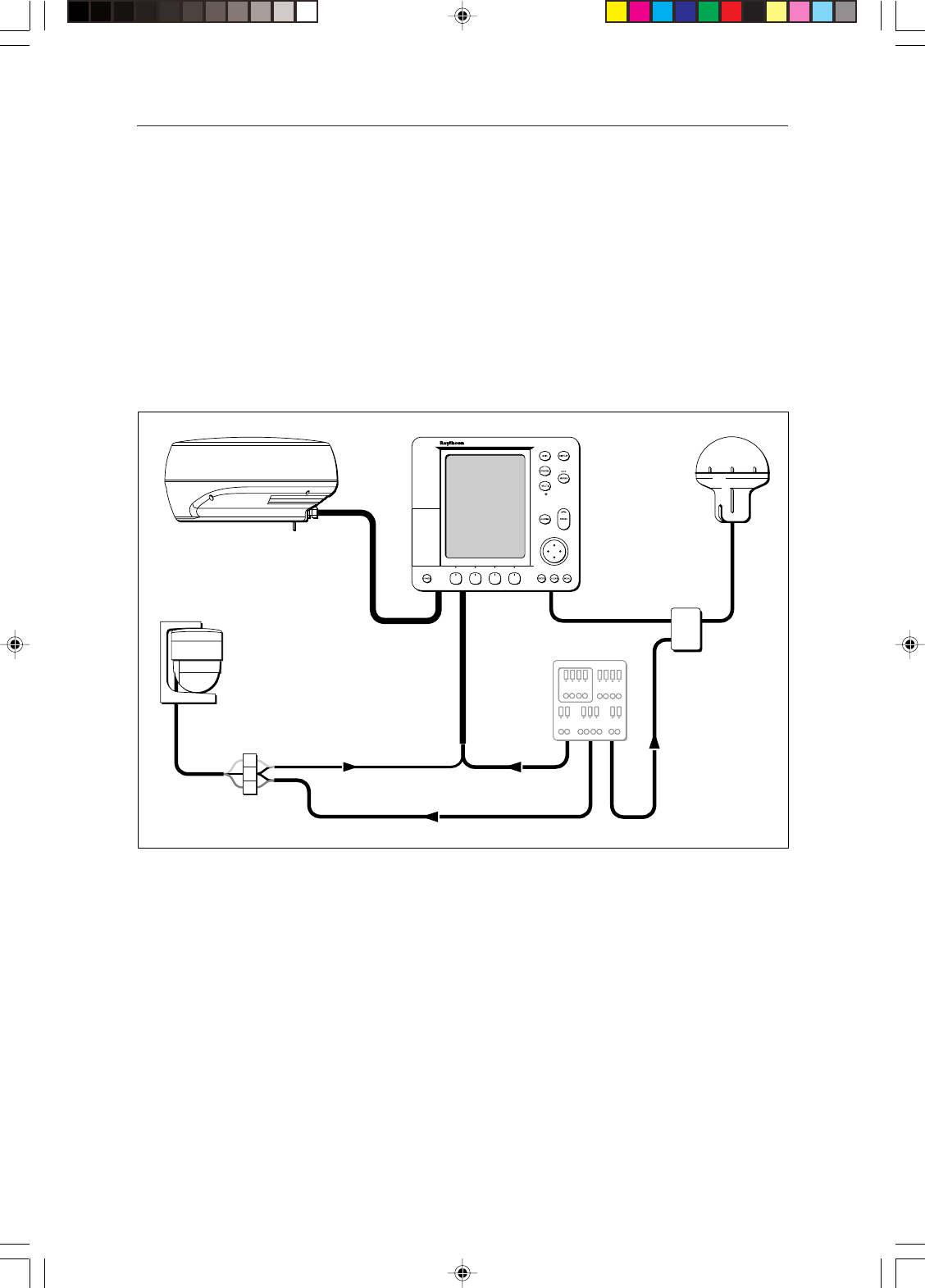
Chapter 1: Overview 1
Chapter 1: Overview
1.1 Introduction
This handbook provides instructions to assist you to install and set up the
following radar scanners:
18" Radome Scanner
24" Radome Scanner
A typical Pathfinder Radar system is illustrated below.
NMEA
SeaTalk
Display Unit
Distribution Panel
D4288-2
Scanner
12/24V Supply
12V Supply 12V Supply
Junction
Box
GPS
Compass
This handbook is divided into three chapters as follows:
Chapter One provides an overview of the scanner installation. It includes
sections on Unpacking and Inspecting the Components, Selecting the Scanner
Site and a description of the Cable Runs.
Chapter Two provides detailed instructions to mount and connect each type of
scanner.
Chapter Three provides instructions to perform the system checks, aligment
and adjustments.
154_1c1.p65 24/12/98, 08:541
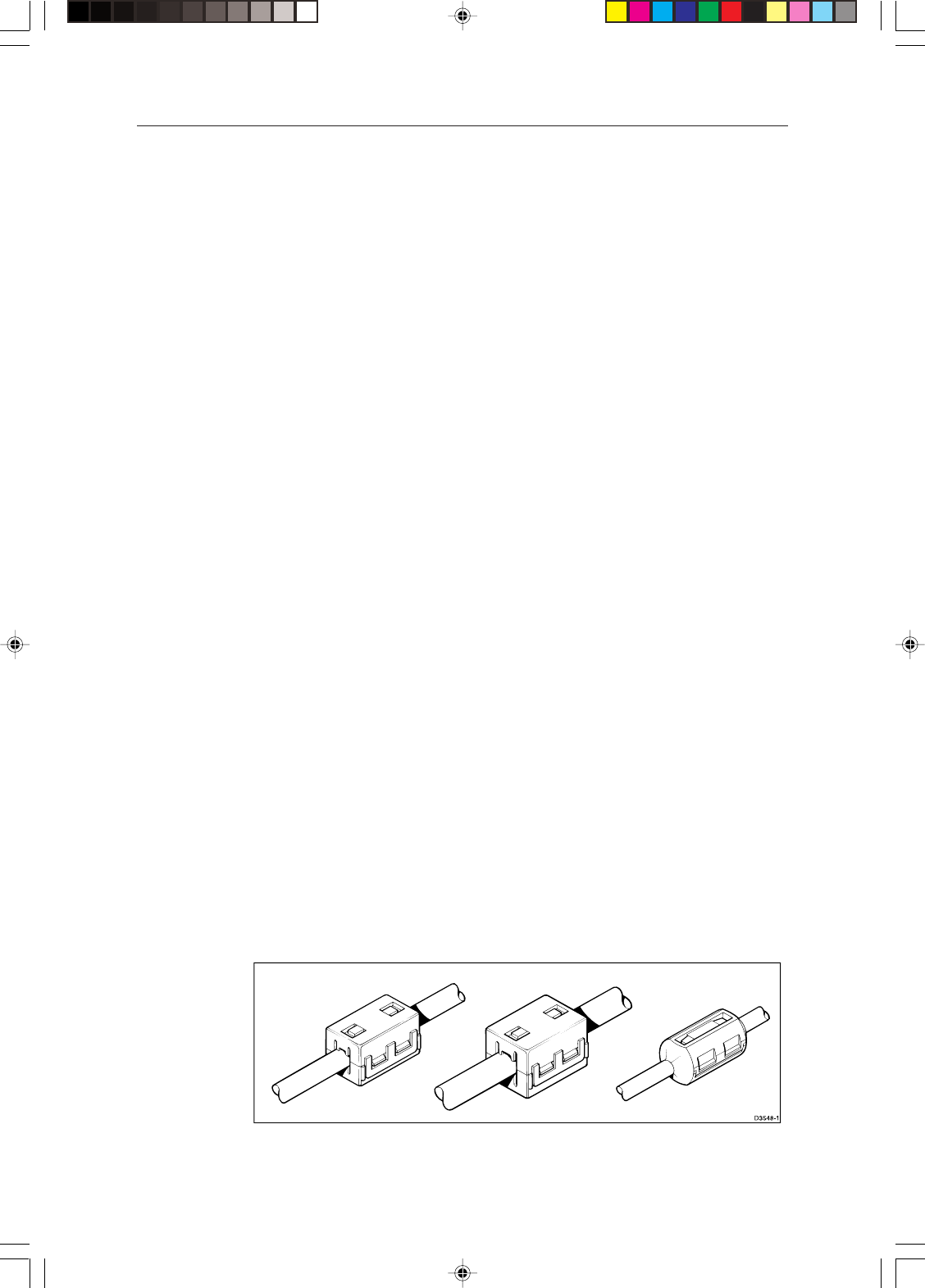
2Pathfinder Radar Scanners
EMC Installation Guidelines
All Raytheon equipment and accessories are designed to the best industry
standards for use in the leisure marine environment.
Their design and manufacture conforms to the appropriate Electromagnetic
Compatibility (EMC) standards, but correct installation configuration is
essential to maintain EMC performance and CE compliance. Although every
effort has been taken to ensure that they will perform under all conditions, it is
important to understand what factors could affect the operation of the product.
To avoid the risk of operating problems, all Raytheon equipment, and cables
connected to it, should be installed as follows:
• Ensuring you follow the installation instructions in Chapter 2, particular
with reference to earthing details.
• With at least 1m (3ft) from any equipment transmitting or cables carrying
radio signals e.g. VHF radios, cables and antennas. In the case of SSB radios,
the distance should be increased to 2m (7ft).
• Avoiding the beam from another radar scanner. A radar beam can normally
be assumed to spread 20 degrees above and below the radiating element.
• The equipment should be supplied from a different battery than the one used
for engine start. Voltage drops below 10.7V in the power supply to our
products can cause the equipment to reset. This will not damage the
equipment, but will cause the loss of some information and can change the
mode of operation.
• Genuine Raytheon cables must be used at all times. Cutting and rejoining
these cables can compromise EMC performance and must therefore be
avoided unless specifically detailed in this handbook.
• If a suppression ferrite is attached to a cable, this ferrite must not be removed.
If the ferrite has to be removed during installation it must be reassembled in
the same position. Section 2.1 Installing the Radome Scanner includes
instructions on fitting a ferrite.
The following illustration shows a typical range of suppression ferrites fitted to
Raytheon equipment.
154_1c1.p65 24/12/98, 08:542

Chapter 1: Overview 3
If your Raytheon equipment is going to be connected to other equipment using
a cable not supplied by Raytheon, a suppression ferrite MUST always be fitted
to the cable close to the Raytheon unit.
1.2 Unpacking and Inspecting the Components
Unpack your system carefully, to prevent damage to the equipment. It is good
practice to save the carton and packing for future use, in case you need to return
the unit for service.
Check that you have all the correct system components. These depend on your
system package, as follows:
ItemItem
ItemItem
Item Part No.Part No.
Part No.Part No.
Part No. SuppliedSupplied
SuppliedSupplied
Supplied OptionOption
OptionOption
Option
with:with:
with:with:
with: for:for:
for:for:
for:
Radome ScannersRadome Scanners
Radome ScannersRadome Scanners
Radome Scanners
2D 18" 2kW Radome Scanner M92650 US Version -
2DE18" 2kW Radome Scanner M92650E European Version -
4D 24" 4kW Radome Scanner M92652 - -
Radome Scanner Accessories Radome Scanner Accessories
Radome Scanner Accessories Radome Scanner Accessories
Radome Scanner Accessories (2D & 4D Variants)
Inter-unit cable 15 m heavy M92668 4D -
Inter-unit cable 25 m heavy M92669 - Both
Inter-unit cable 10 m light M92692 2D (US version) -
Inter-unit cable 15m light M92720 2D (Europe version) -
Extension cable 5m M92699 - Both
Extension cable 10m M92700 - Both
Mast Mount 18" Scanner M92722 - 2D
Mast Mount 24" Scanner M92698 - 4D
Radar Interface adapter M92721 - 2D
To fit radome to M88390 type 18" mast mount
Radome mounting interface plate M92731 - 2D
To mast mount the radome
Supplied with HSB Series Display UnitSupplied with HSB Series Display Unit
Supplied with HSB Series Display UnitSupplied with HSB Series Display Unit
Supplied with HSB Series Display Unit
Ferrite Clamp R55007 - Both
154_1c1.p65 24/12/98, 08:543

4Pathfinder Radar Scanners
1.3 Selecting the Scanner Unit Site
This section provides information that affects the possible locations of the
scanner, and its position relative to the display unit and to the power supply.
The dimensions of the each scanner unit are shown in the following diagrams.
Selecting the best location for the scanner unit requires careful consideration of
the following points, to ensure reliable and trouble free operation:
Note: In order to minimise potential interference to other systems on board ship
(EMC), it is advisable to mount the scanner on a part of the boat that is insulated
from the ship’s battery negative. If you cannot do this, and encounter problems,
you can fit insulating bushes between the scanner and its mounting bracket.
•Height: The scanner unit should normally be mounted as high as practical
above the waterline, for two reasons:
- Radar operates at the line-of-sight, so a high mounting position gives
better long range performance.
- Surrounding large objects, in the same horizontal plane, can interfere with
the radar signal and cause blind areas (shadow sectors) and false targets on
the radar screen (see below).
However, do not mount the scanner so high that it is affected by the pitching
and rolling of the vessel. In addition, you may need to lower the scanner to
avoid creating a shadow sector.
•Access: The scanner unit site should be easily accessible to allow
maintenance to be carried out safely.
•Safety: The scanner should be out of range of personnel (above head height).
•Magnetic compass: Mount the display unit at least 1m away from a
magnetic compass.
•Cable run: The maximum length of cable between the display unit and the
scanner unit should not normally exceed 20m (60ft) for radome scanners. If
you need to use a longer cable, refer to Section 1.4 Cable Runs.
•Shadow sectors and false echoes: Mount the scanner away from large
structures or equipment, such as the fly bridge, large engine stacks,
searchlights, horns, or masts. It is particularly important to avoid shadow
sectors near the bow. Raising or even lowering the scanner may help to
reduce these effects.
In shadow areas beyond the obstruction there will be a reduction of the beam
intensity, although not necessarily a complete cut-off; there will be a blind
sector if the subtended angle is more than a few degrees.
In some shadow sectors the beam intensity may not be sufficient to obtain an
echo from a very small object, even at close range, despite the fact that a
154_1c1.p65 24/12/98, 08:544

Chapter 1: Overview 5
large vessel can be detected at a much greater range. For this reason the
angular width and relative bearing of any shadow sector must be determined
at installation. Sometimes shadowing can be seen by increasing the radar
gain until noise is present. Dark sectors indicate possible shadowed areas.
This information should be posted near the display unit and operators must
be alert for objects in these blind sectors.
It should also be noted that wet sails create shadow areas and thus sail boat
operators should be aware that radar performance may reduce in rain.
If you mount the scanner on a mast, echoes from the mast may appear on the
radar display. These can be minimised by placing absorbing material, such
as a block of wood, between the scanner and mast.
•Platform rigidity/stability: The scanner platform should not twist (causing
bearing errors) or be subject to excessive vibration.
•Heat/fumes: Mount the scanner away from the top of exhaust stacks, since
the scanner and cables can be damaged by excessive heat and the corrosive
effects of stack gases.
Mounting Surface: Sailboats
The scanner unit can be installed on a mast platform, an arch, or a bridge
structure. Make sure that the platform surface is flat and the scanner unit drain
hole is not obstructed. Raytheon recommends that radome scanner units are
best suited for sailboat operation as open array systems are more difficult to
protect from ropes and sails.
For sailboat installations, Raytheon offers a universal mast mount kit for each
scanner type. These optional mounts are used to fit masts, with a minimum
diameter of 60 mm (2½in), to a flat surface. When using the mast mount kit,
appropriate hardware should be used for the style and structure of the mast
aboard the vessel.If there is any doubt concerning the appropriate type of
hardware, consult your boat dealer or representative for their recommendations.
Depending on the type of sailboat, a radar scanner guard should be installed if
the sails could touch the scanner or platform. Without a proper radar guard the
mounting platform and the radar scanner could be severely damaged.
Mounting Surface: Power Boats
On many small vessels the scanner unit can be installed on a mast platform, an
arch, or a bridge structure. If necessary, construct a radar mounting pedestal to
obtain a sufficiently high mounting position. Make sure that the platform
surface is flat and the scanner unit drain hole is not obstructed. Ensure the
platform is strong enough to support the maximum shock loads likely to occur.
154_1c1.p65 24/12/98, 08:545
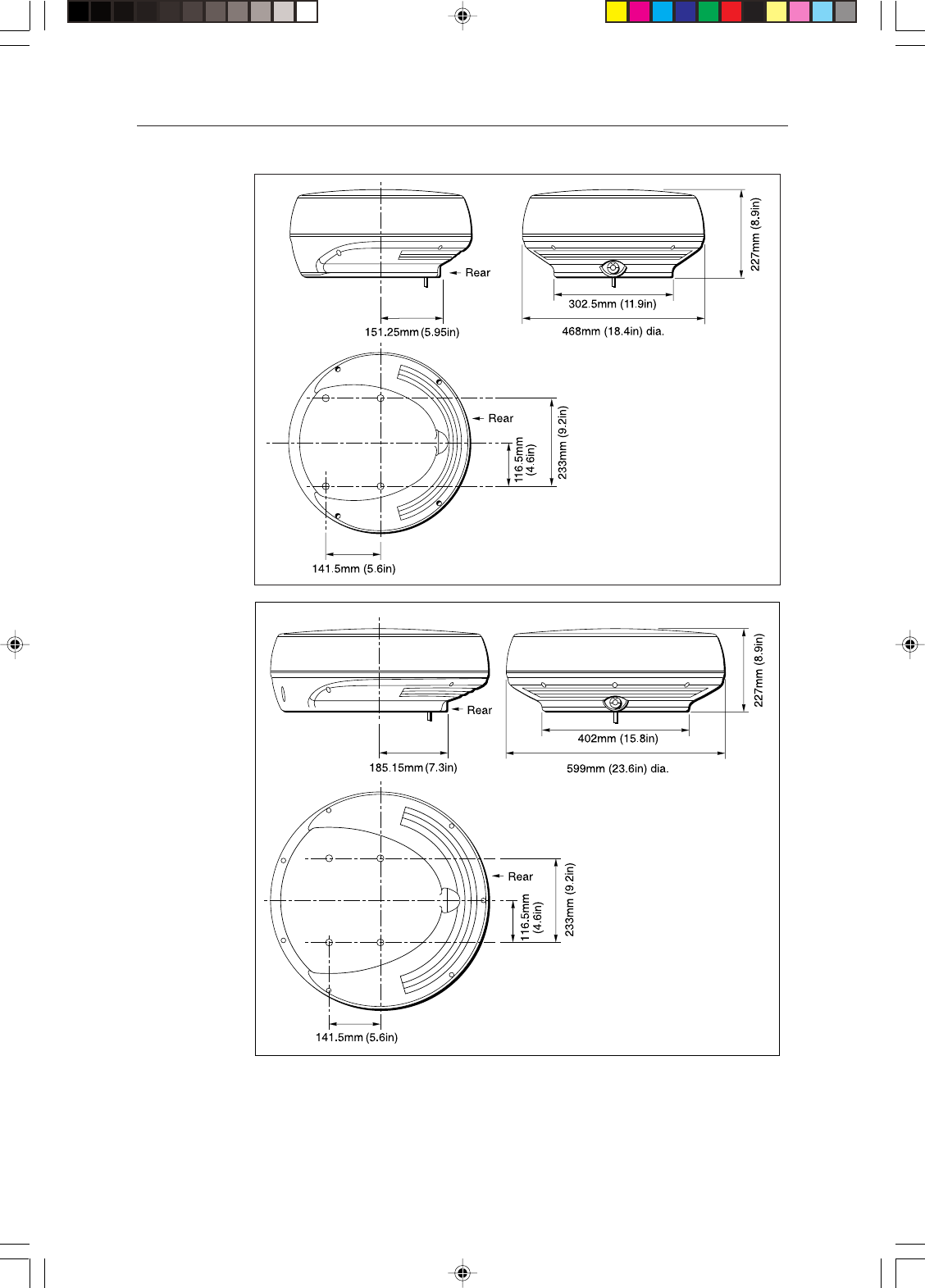
6Pathfinder Radar Scanners
D3224_3
Weight: 6.5 kg (14.3lbs)
Compass Safe Distance: 1m (33")
18" Radome Scanner
D3228_4
Weight: 7.5 kg (16.5lbs)
Compass Safe Distance: 1m (33")
24" Radome Scanner
154_1c1.p65 24/12/98, 08:546
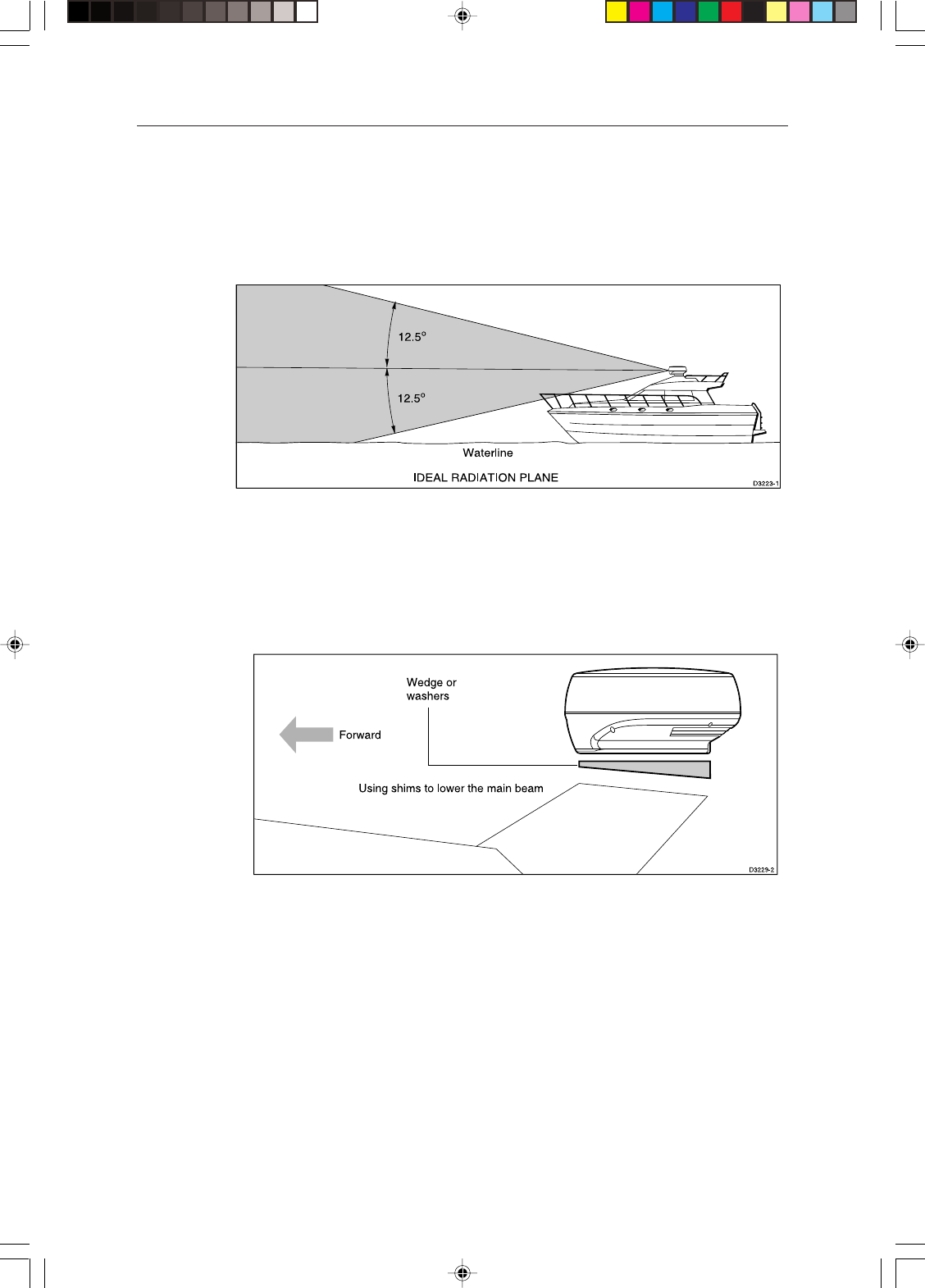
Chapter 1: Overview 7
Setting the Radiation Plane
The scanner unit should be mounted so that the array rotates parallel to the
waterline. The radar beam is approximately 25° wide in the vertical direction,
providing good target detection during the vessel’s pitching and rolling.
Planing hull vessels, and some displacement hull vessels, adopt a higher bow
angle when the vessel is at its cruising speed. In many cases this substantially
alters and raises the radar’s main radiation plane, and can cause poor detection
of nearby targets. It may be helpful to lower the radar beam back towards the
parallel, by shimming the rear of the radar, so that the beam points slightly
downwards with respect to the waterline when the vessel is at rest.
The shims may be made from aluminium plate wedges, simple flat washers, or
an angled wooden block. For thick shims, you may need longer securing bolts
than the M8x40 bolts supplied with the scanner.
154_1c1.p65 24/12/98, 08:547

8Pathfinder Radar Scanners
1.4 Cable Runs
You need to consider the following before installing the system cables:
– You need to fit the inter-unit cable and the power cable.
– All cables should be adequately cleated and protected from physical
damage and exposure to heat - avoid running cables through bilges or
doorways, or close to moving or hot objects.
– Acute bends must be avoided
– Where a cable passes through an exposed bulkhead or deckhead, a
watertight gland or swan neck tube should be provided.
You need to run the following cables:
CAUTION
Do not pull the cable through bulkheads using a cord attached to the 8-way
connector. This could damage the connections.
•Inter-unit cable, supplied with the scanner unit. This is vinyl-covered and
shielded, with a connector plug at one end for connecting to the display unit
or extension cable. The other end of the radome scanner cable is fitted with
an 8-way plug and power cores (covered by a clear protective sleeve) for
connecting to the scanner.
• Power cable, the scanner receives power via the display unit. The power
cable is supplied with the display unit. However, connection details are
provided in this section.
Inter-Unit Cable - Radome Systems
The inter-unit cable entrance is at the rear of the scanner unit. If the unit is
mounted on a hollow mast the cable may be run inside the mast and then fed
through the radar’s cable entrance. Make sure that the cable does not chafe
where it enters and exits the mast.
Note: Route the cable from the display up to the scanner, since this will require
the smallest clearance hole.
CAUTION
The display connector on the inter-unit cable is a moulded plug that
cannot be replaced. DO NOT remove this molded plug.
The inter-unit cable, for connecting the scanner to the display unit, depends on
your scanner package as follows:
154_1c1.p65 24/12/98, 08:548

Chapter 1: Overview 9
Scanner PackageScanner Package
Scanner PackageScanner Package
Scanner Package Inter-Unit CableInter-Unit Cable
Inter-Unit CableInter-Unit Cable
Inter-Unit Cable
2D (US) 10m light (2 power cores)
2DE (European) 15m light (2 power cores)
4D 15m heavy (4 power cores)
The minimum bends permitted are:
Minimum bend, light cable 60 mm (~2.5 in) radius
Minimum bend, heavy cable 82 mm (~3.75 in) radius
The length of the supplied cable should be sufficient to complete the cable run
required on most small vessels. For longer runs, additional or replacement
cables are available, which have 4 power cores to minimise voltage drops over
the longer cable run: these optional cables include 5m and 10m extension
cables, and a 25m replacement cable.
The maximum inter-unit cable length is limited by the minimum supply
voltage, the scanner type (18" radome or 24" radome), and the cable type (2 or 4
power cores): if a mix of light and heavy cables is used, only 2 power cores are
connected through.
Note: For vessels with 24V power systems, any combination of inter-unit
cables can be used.
For vessels with 12V power systems, the recommended cable(s) for different
run lengths are given in the following table, which assumes a minimum supply
voltage of 10.7V (the lowest voltage likely to be reached by a 12V battery in
normal marine use). Do not use cable combinations that are not included in
the table.
Recommended Radome Inter-Unit Cable(s) for Vessels with 12V Power
Systems
Inter-Unit Cable Scanner Package
Length Required (m) 2D (US) 2DE (Eur) 4D
10 Std 10m light N/A N/A
15 Std + 5m ext Std 15m light Std 15m heavy
20 Std + 10m ext 25m assembly Std + 5m ext
25 25m assembly 25m assembly Std + 10m ext
30 25m + 5m ext 25m + 5m ext 25m + 5m ext
35 25m + 10m ext 25m + 10m ext 25m + 10m ext
Refer to the packing list in Section 1.2 for cable part numbers
154_1c1.p65 24/12/98, 08:549

10 Pathfinder Radar Scanners
Note: This table applies to systems using the standard 1.5m power cable. If you
extend the power cable you may need to select different inter-unit cable(s), as
discussed in the following section Power Cable.
Note: If you are mounting the scanner on a sailboat, and will need to unstep the
mast, you should install a suitable junction box inside the boat. The junction
box should provide an 11- or 13-way terminal strip, depending on the number
of power cores in your cable, with a 10A rating. If cutting and joining the cable,
be careful not to damage any of the wires, and make sure that all the wires and,
in particular, the screen are re-connected correctly. Also, you should keep the
length of the un-screened coaxial cores to less than 50mm to maintain EMC
conformance.
Power Cable - Radome
The radome radar systems are intended for use on ships’ DC power systems
operating in the 10.7 to 32V DC range (that is, 12V and 24V systems, not 32V
systems). A 1.5m (5ft) power cable is supplied (with the display unit)for
connecting the ship’s DC power to the radar scanner via the display unit.
If a longer power cable run is required, use the supplied power cable to connect
to the display unit. Then use a suitable connector block to connect the free end
to the extension cable. The supplied power cable has a cross-section of 2.0mm2.
Note: For vessels with 24V power systems, the power cable may be extended
by up to 20m using a wire gauge of 1.5mm2 (AWG 16) or greater, irrespective
of the inter-unit cable length.
For vessels with 12V power systems, longer power cable runs may require
larger wire gauges to minimise any voltage drop in the cable. The scanner type
and the length and type of the inter-unit cable (see tables) also affect the wire
gauge required for the extension power cable. In order to determine the correct
supply cable size if the power cable must be extended, estimate the length of
cable between the ship’s main power source and the connector block, and then
select the wire size indicated by the distance and inter-unit cable in the
appropriate table following.
For example, you might have a 24" scanner, with 20m between the scanner and
display unit, that you plan to connect by extending the supplied 15m heavy
inter-unit cable with a 5m extension cable. In addition, your 12V power supply
might be 10m from the display unit, requiring an extension of 8.5m. To
determine the wire gauge required for the power cable extension, refer to the
table for the 24” scanner, go to the row labelled “15m Heavy + 5m ext”, and
read across until you come to a maximum cable length greater than 8.5m. This
is the 10m entry, in the column for 4.0mm2 wire gauge.
154_1c1.p65 24/12/98, 08:5410

Chapter 1: Overview 11
Maximum Extension Power Cable Lengths (m), 12V Systems with 18"
Radome Scanner
Inter-Unit Cable(s) Power Cable Core
mm2: 1.5 2.0 2.5 4.0 6.0 10.0
AWG: 16 15 14 12 10 8
10m Light 5.0 7.0 9.0 14.0 20.0 35.0
10m Light + 5m ext 1.0 2.0 3.0 4.5 7.0 12.0
10m Light + 10m ext Do NOT extend the power cable
15m Light 1.0 2.0 3.0 4.5 7.0 12.0
15m Heavy 7.0 10.0 13.0 20.0 30.0 50.0
15m Heavy + 5m ext 5.0 7.0 10.0 15.0 25.0 40.0
25m Heavy 4.5 6.0 8.0 12.0 20.0 35.0
25m Heavy + 5m ext 3.5 4.5 6.0 9.0 15.0 25.0
25m Heavy + 10m ext 2.0 3.0 4.0 6.0 9.0 15.0
Note: If you have an 18" radome scanner, and the wire gauge required for your
extended power cable is unacceptably large, you should replace the supplied
light (2 power core) inter-unit cable with the 25m heavy (4 power core) inter-
unit cable assembly (see table).
Maximum Extension Power Cable Lengths (m), 12V Systems with 24"
Radome Scanner
Inter-Unit Cable(s) Power Cable Core
mm2: 1.5 2.0 2.5 4.0 6.0 10.0
AWG: 16 15 14 12 10 8
15m Heavy 5.0 7.0 9.0 14.0 20.0 35.0
15m Heavy + 5m ext 4.0 5.0 6.0 10.0 15.0 25.0
15m Heavy + 10m ext 2.0 3.0 4.0 7.0 10.0 17.0
25m Heavy 2.0 3.0 4.0 7.0 10.0 17.0
25m Heavy + 5m ext 1.0 1.5 2.0 3.0 4.0 8.0
25m Heavy + 10m ext Do NOT extend the power cable
154_1c1.p65 24/12/98, 08:5411

12 Pathfinder Radar Scanners
154_1c1.p65 24/12/98, 08:5412
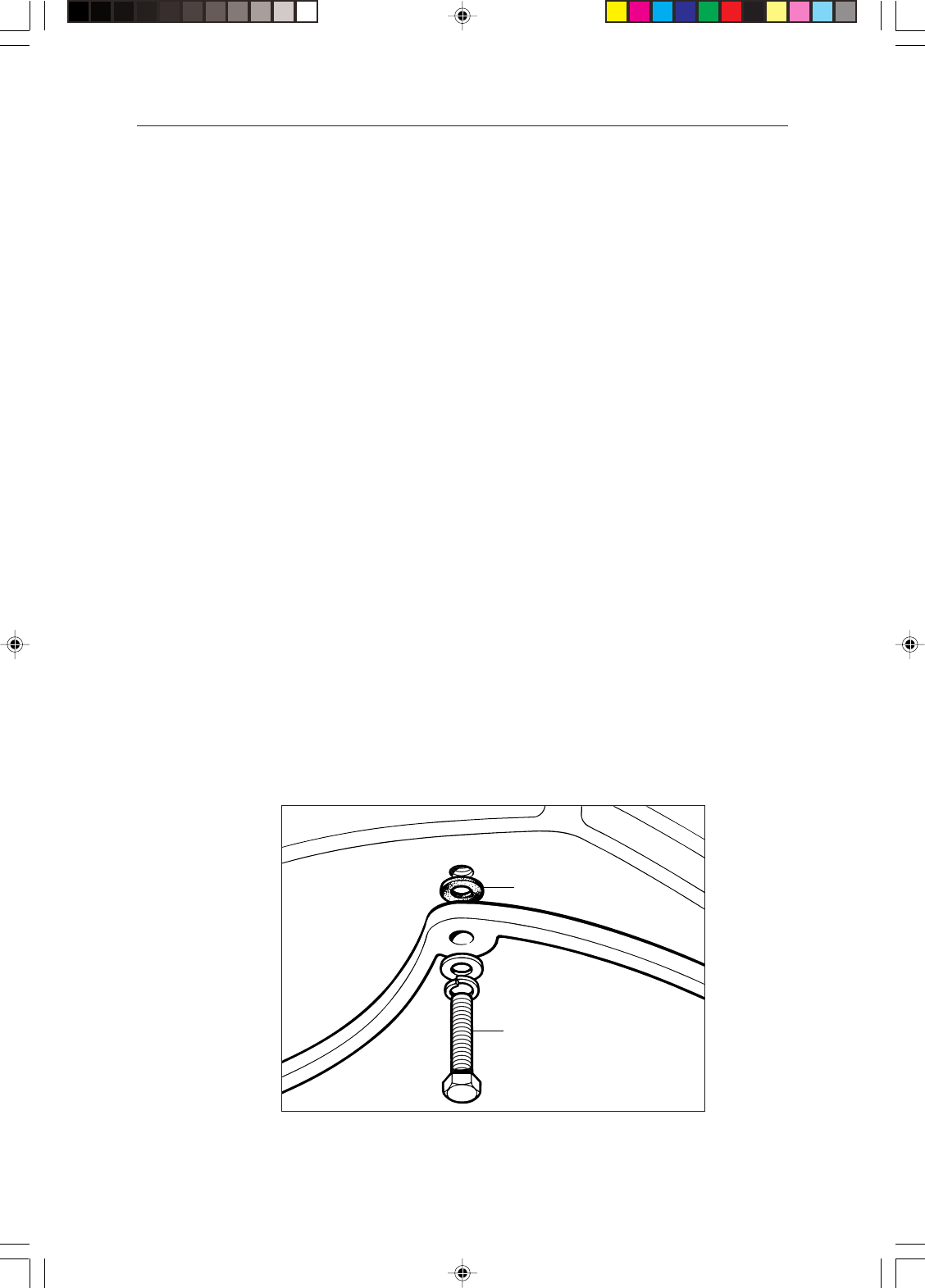
Chapter 2: Installing the Scanner 13
Chapter 2: Installing the Scanner
2.1 Radome Scanner
Securing the Radome Scanner to the Mounting Surface
CAUTION
THE DRAIN TUBE MUST ALWAYS BE USED, BUT MAY BE
SHORTENED IF NECESSARY
1. Using the paper template supplied with the scanner mounting kit, mark the
flat mounting surface with the mounting holes and drain tube hole, and drill
the holes as indicated on the template.
If it is impractical to drill a hole for the drain tube, then the scanner unit
should be mounted on 4 suitable spacers 10 mm high and the drain tube
length reduced by 10 mm. It will then be clear of the flat surface and can
still perform its function.
Note: If you are using a Raytheon mast mount bracket, the surface is pre-
prepared.
Note: If you are mounting the scanner on a flat surface, you may find it
easier to fit the drain tube, as described in the following section, before
securing the scanner.
2. Position the scanner on the mounting surface, ensuring that the cable inlet is
pointing aft.
3. Locate the bolts and washers supplied with the scanner, grease the bolts,
and secure the scanner to the mounting surface as shown in the following
diagram.
Scanner base
Mounting bracket
or mounting surface
Greased mounting bolt
D3995-2
Bitumen washer
You may need to use longer M8 mounting bolts to secure the scanner if you
have used shims to lower the main beam.
154_1c2.p65 24/12/98, 08:5513
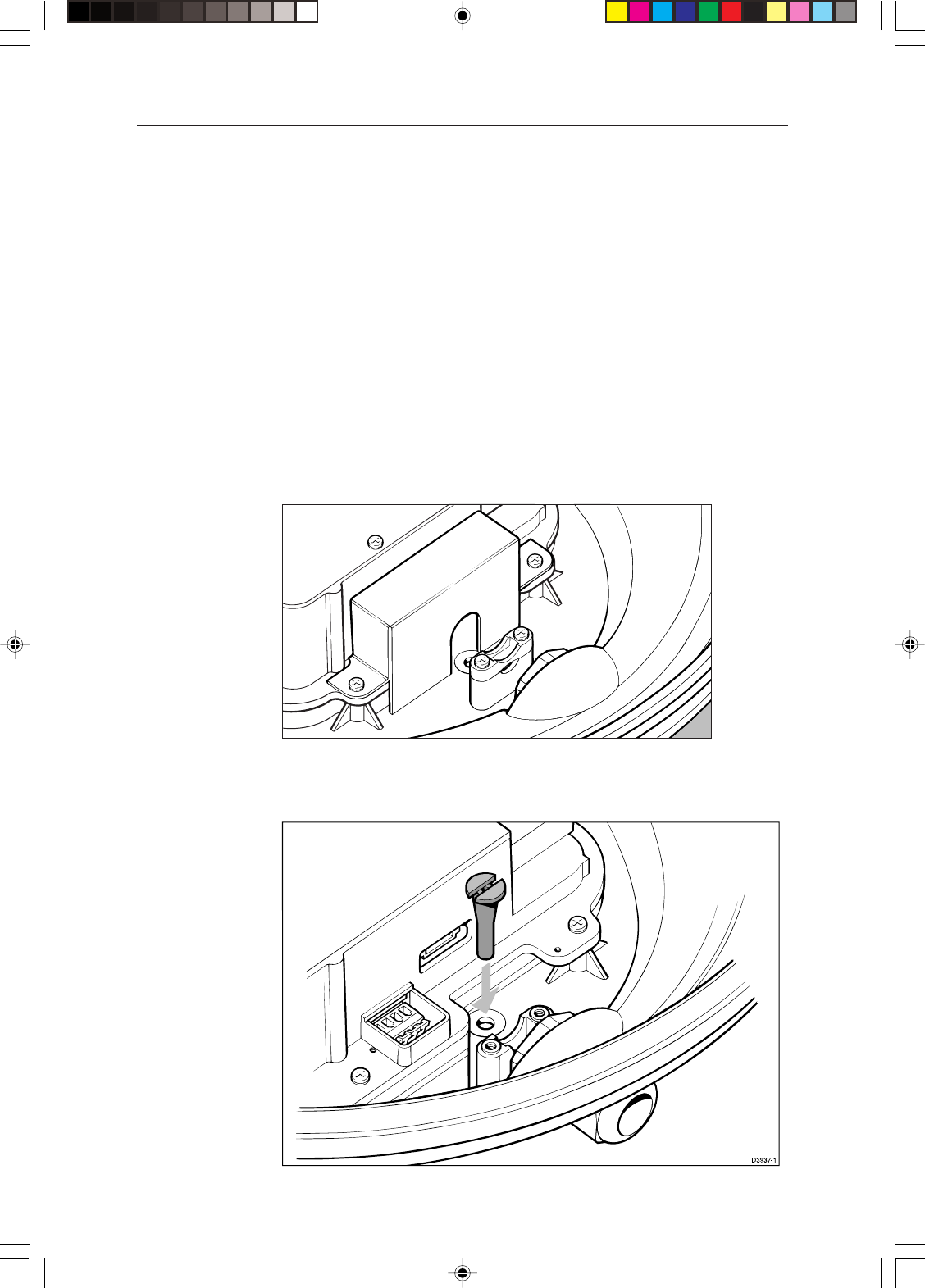
14 Pathfinder Radar Scanners
Connecting the Radome Scanner
CAUTION:
Before wiring the scanner unit, make sure that the inter-unit cable is not
connected and power is not applied to the display unit.
When you have run the inter-unit cable to the scanner location, connect the
cable as follows:
1. Loosen the 4 (18") or 7 (24") screws securing the scanner cover. These
screws are captive and should remain assembled to the lower flange
assembly. Press the radome inwards to release the top. This breaks the seal
and makes removal easier.
2. To avoid losing the scanner cover, tie the cord, attached to the inside of the
base of the scanner, to the eye provided in the cover.
3. If you have a 24" scanner, unscrew and remove the inner cover:
D4006-1
Inner cover
4. Remove the drain tube from inside the base of the scanner, and insert it into
the drain hole as shown in the following diagram. Pull the tube gently from
outside the scanner so that it clips into place.
154_1c2.p65 24/12/98, 08:5514
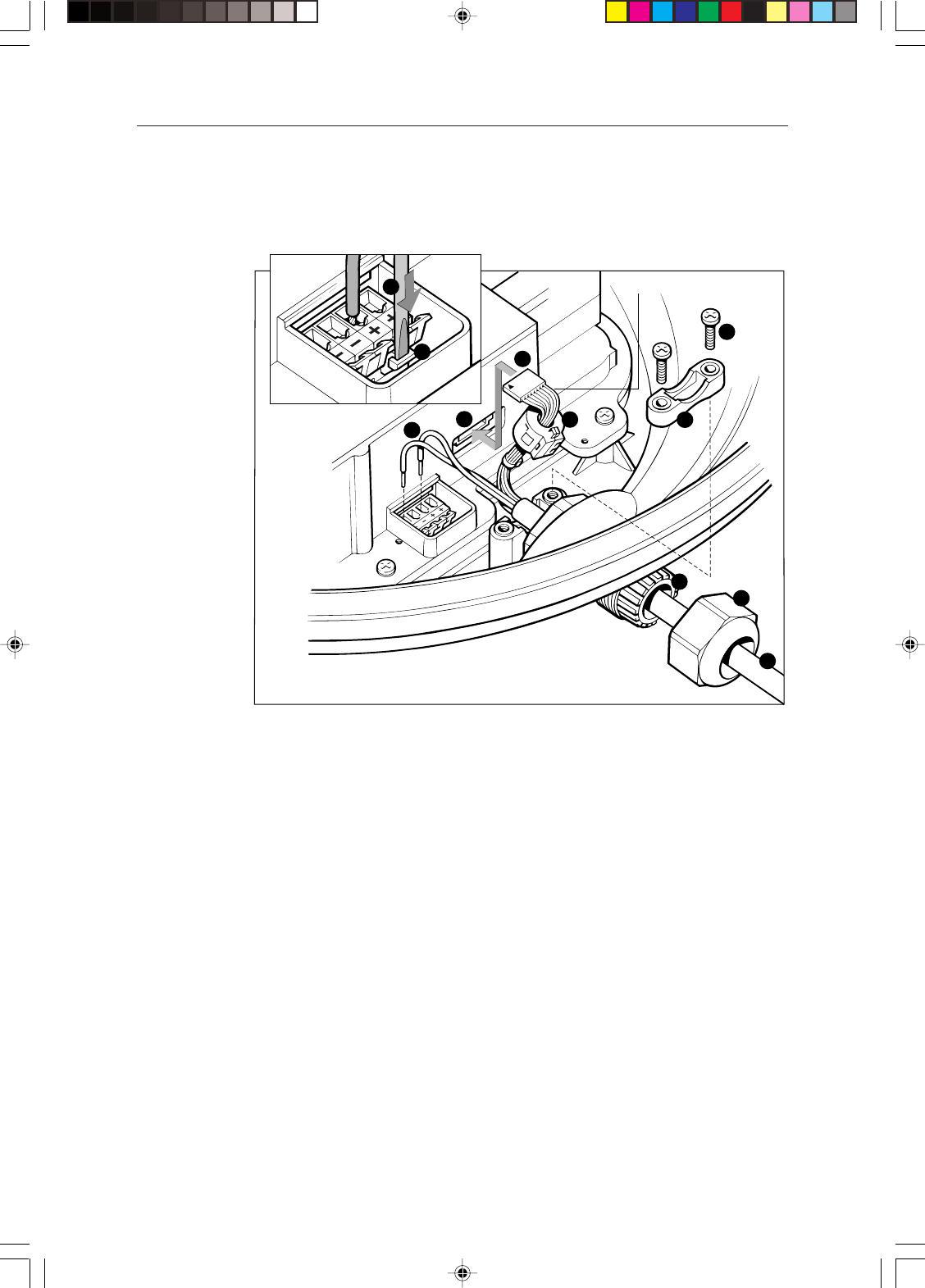
Chapter 2: Installing the Scanner 15
5. Referring to the following illustration, remove the securing nut (1) from the
watertight gland and grommet (2), where the inter-unit cable (3) will enter
the base.
D3230-3
10
4
59
White wire
6
3
1
2
11
7
8
1 Securing nut 2 Gland 3 Inter-unit cable 4 Eight-way plug 5 Eight-way socket 6 Power
cores (2 or 4) 7 Terminal clamp 8 Screwdriver 9 Cable clamp 10 Cable clamp screws 11
Ferrite clamp
6. Slide the gland nut onto the inter-unit cable (3), and insert the cable, still
covered by its protective sleeve, through the gland into the base.
7. Cut and remove the protective sleeve to expose the 8-way plug (4) and
power cores (6).
8. If the scanner is connected to an HSB Series Pathfinder Radar display, fit
the ferrite clamp (11), supplied loose with the display unit, as follows:
- the ferrite clamp is supplied open. If the clamp has been closed, insert a
small, flat-bladed screwdriver into the slots at the end of the clamp
opposite the hinge and twist gently.
- Position one-half of the clamp around the eight cores of the inter-unit
cable between the 8-way plug (4) and the cable clamp, as close to the 8-
way plug as possible. (It may be necessary to fit the clamp over the the
cable tie closest to the 8-way plug – this will not affect the ferrite
clamp’s function).
154_1c2.p65 24/12/98, 08:5515

16 Pathfinder Radar Scanners
Ensure that the flat, ferrite side of the clamp does not trap or pinch any
of the cables.
Note: on the 24" scanner, the clamp must be contained inside the inner
cover.
- With the clamp positioned correctly, close the clamp ensuring none of
the cores are trapped by the hinge or latch.
9. Connect the 8-way plug (4) to the connector (5). The correct fitting is with
the small arrow marked on the body of the plug facing upwards and to the
left hand side. The grey wire will then be at the left hand side and the white
wire will be at the right hand side.
10. Connect the red and black power cores (6).
If you have a 10m or light 15m inter-unit cable, there is one pair of cores.
Connect the red cable lead to one of the terminal sockets marked “+”, and
the black cable lead to one of the sockets marked “-”.
If you have a heavy 15m inter-unit cable, there are two pairs of cores.
Connect the red cable leads to the terminal sockets marked “+”, and the
black cable leads to the terminal sockets marked “-”, with one lead in each
socket.
The terminal clamps (7) are operated using a screwdriver (8), as shown in
the inset diagram on the previous page.
CAUTION:
Do not earth the cable screen to the scanner. The radar system is earthed
via the display unit.
11. Secure the nut on the watertight gland, making sure that it grips the cable’s
outer sheath.
12. Secure the cable with the cable clamp (9), using the two screws (10)
provided. The clamp can be installed either way up, depending on the
thickness of the cable: use the position that matches the profile of the cable.
13. Tighten the securing nut (1) again to ensure a waterproof seal.
14. If you have a 4D scanner, replace the inner cover over the connectors.
15. Untie the cord from the scanner cover, and coil it up in the base of the
scanner unit so that it cannot foul the rotating antenna.
16. Replace the scanner cover, aligning the mark on the cover with the mark on
the scanner base above the cable gland, and tighten the 4 or 7 captive
screws. Do not over-tighten these screws.
154_1c2.p65 24/12/98, 08:5516

Chapter 2: Installing the Scanner 17
2.2 System Connections
Power is supplied to the scanner via the display unit; the power cable is supplied
with the display unit, refer to your display unit Owner’s Handbook for details
on connecting power. However, you should be aware of the following.
Grounding the Radar System
It is important that an effective RF ground is connected to the radar system. You
must ground the radar by connecting the drain wire (screen) of the Power/
NMEA Input cable to the nearest ground point of the ship’s RF ground system.
Refer to your Display Unit Owner’s Handbook for details.
Note: Use only this ground connection.
DC Power Connection - Radome Systems
The Radome radar system is intended for use on ships’ DC power systems
operating in the 10.7 to 32VDC range (12V and 24V systems, not 32V
systems). The connections should be made at a DC power distribution panel,
through an isolation switch or circuit breaker that is fused or trips at not greater
than 10A. Check that all connection terminals are clean.
CAUTION:
If you do not have a breaker in your power circuit, you must fit an in-line
6.3A quick-blow fuse to the positive (red) lead of the power cable.
This radar is not intended for use on “positive” ground vessels.
The power cable Earth screen connections must be connected to the ship’s
ground.
The DC system should be either:
• Negative grounded, with the negative battery terminal connected to the ships
ground.
• Floating, with neither battery terminal connected to the ships ground.
154_1c2.p65 24/12/98, 08:5517
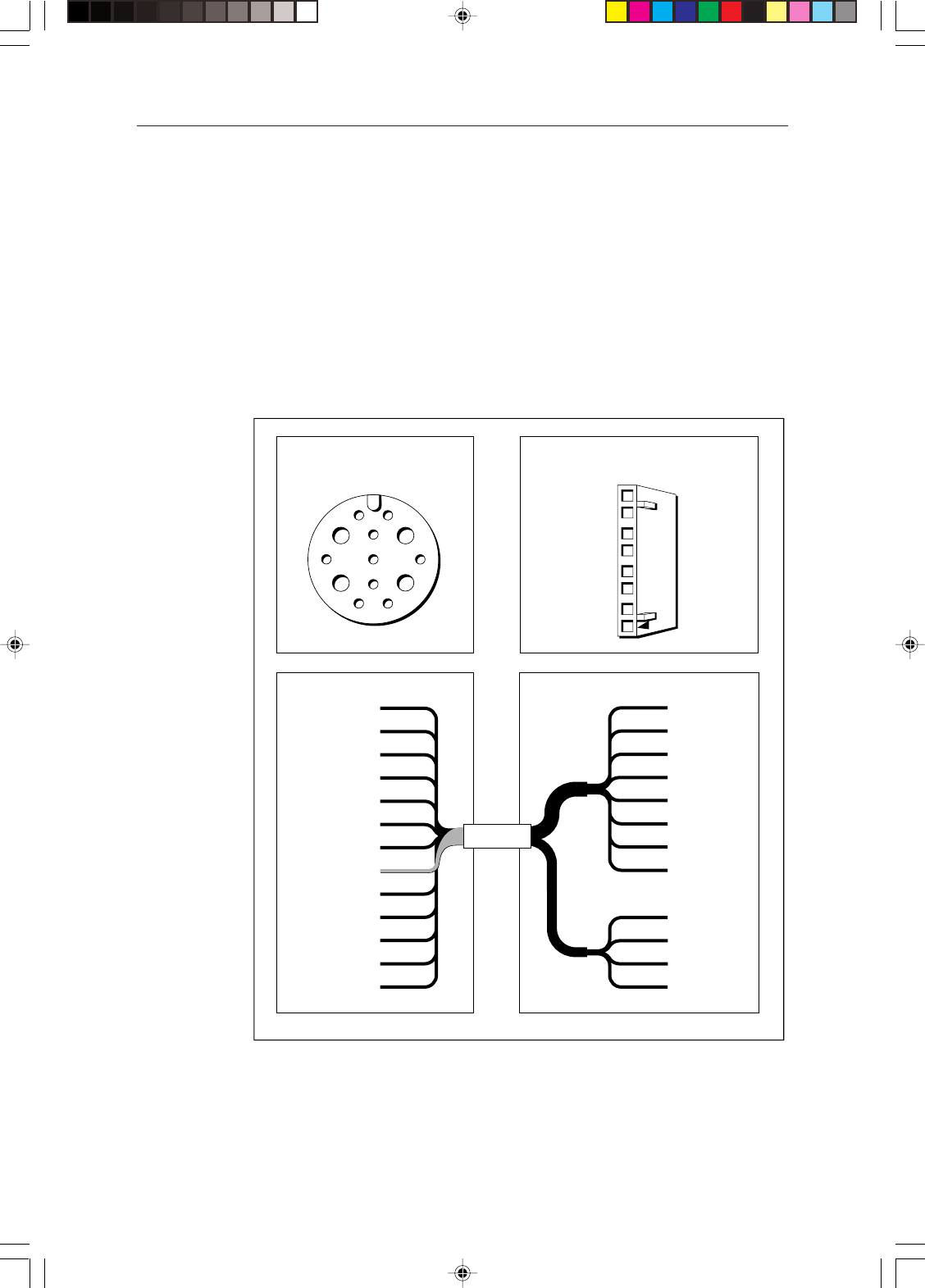
18 Pathfinder Radar Scanners
Scanner Connection
The inter-unit cable is connected to the scanner as described in Section 2.1. If
you are using an inter-unit extension cable, connect this to the display unit, and
connect the supplied cable to the extension cable.
The scanner connector pins are shown in the following diagram, together with
the connections and core colours .
CAUTION
The display connector on the inter-unit cable is a moulded plug that
cannot be replaced. DO NOT remove this molded plug.
1
2
35 4
7
10
11
86
9
13 12
White
Black
Orange
Black
Black
Green
Yellow
Shield
Red
Red
Violet
Blue
Grey
Video
Video RTN
*Battery --ve
Tx Trigger +
Battery --ve
Data I/O +
Tx Trigger --
Battery +ve
Data I/O --
*Battery +ve
Azimuth +
Azimuth --
1
2
3
4
5
6
7
8
9
10
11
12
13
White
Black
Orange
Yellow
Green
Blue
Violet
Grey
Red
Red
Black
Black
8
7
6
5
4
3
2
1
Video
Video Rtn
Tx Trigger +
Tx Trigger --
Data I/O +
Data I/O --
Azimuth +
Azimuth --
Battery +ve
*Battery +ve
*Battery --ve
Battery --ve
D4290-1
Front view of
Display Cable Connector Front view of
Scanner Cable Connector
2
1
4
3
6
5
8
7
Display Scanner
* Not present on 'light', 11 core cables.
Battery +ve/--ve = 12 or 24v.
154_1c2.p65 24/12/98, 08:5518
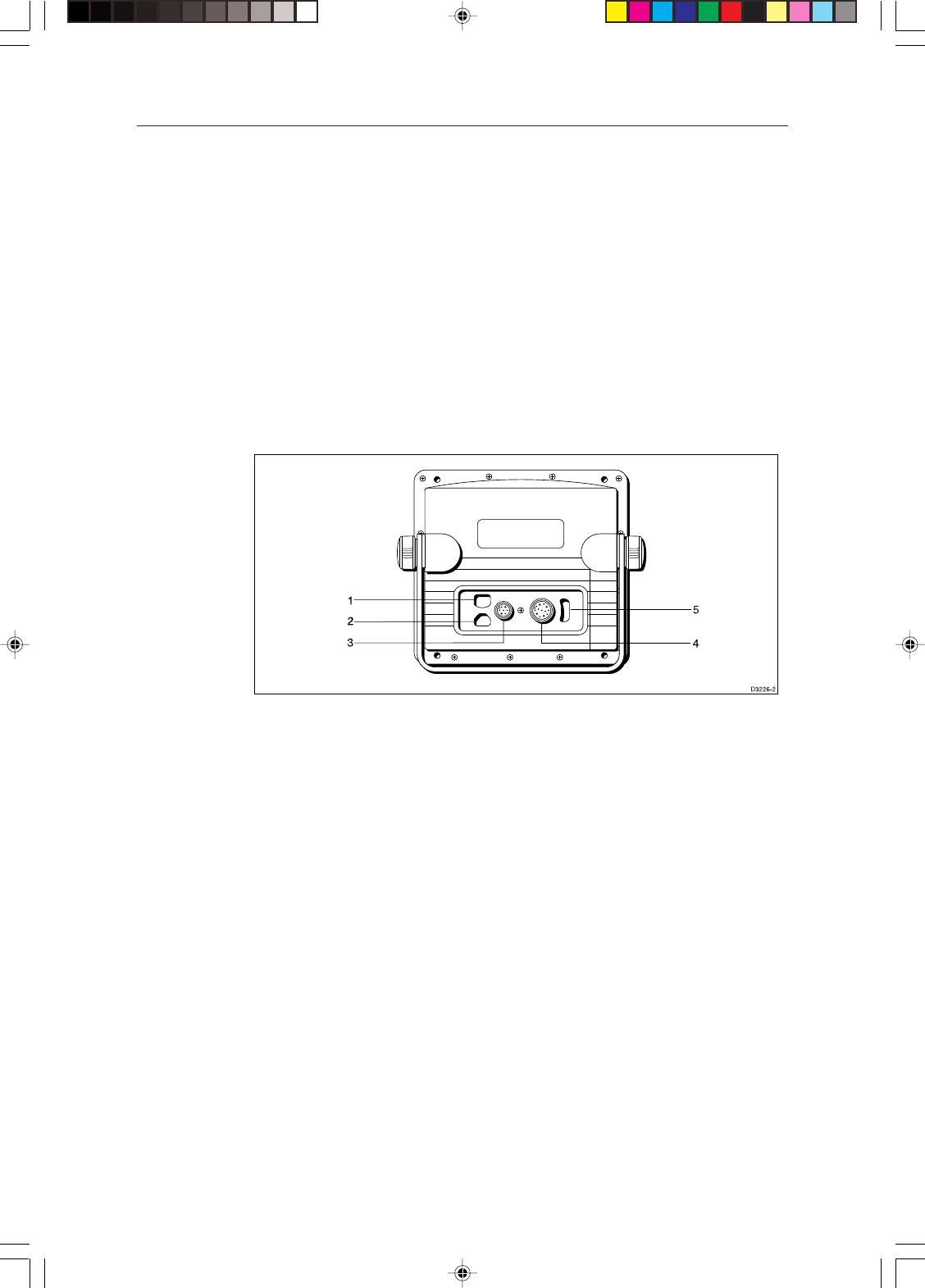
Chapter 2: Installing the Scanner 19
Display Unit Connection
The rear of the Pathfinder display provides the following connection sockets:
•Scanner connection
•HSB, for connecting to another HSB Series display (such as a chartplotter or
second radar display) – not available on SL70 display
•SeaTalk, for SeaTalk data input and output and connecting to another HSB
Series display (such as a chartplotter or second radar display)
•NMEA Output – not available on SL70 display
•Power/NMEA Input, for 12V or 24V DC power connection and two
NMEA 0183 inputs
1 NMEA Output 2 HSB 3 Power and NMEA Input 4 Scanner 5 SeaTalk
Connect the scanner cable to the scanner connection (4) and power to the
power/NMEA input connector (3).
Power and all other connector details are supplied in the display unit Owner’s
Handbook.
154_1c2.p65 24/12/98, 08:5519

20 Pathfinder Radar Scanners
154_1c2.p65 24/12/98, 08:5520

Chapter 3: Systems Test and Post Installation Alignment 21
Chapter 3:
System Tests and Post Installation Alignment
Once you have installed your radar scanner and display unit, and made all the
connections, you need to check your installation. You can then set up the radar
system, align the scanner and check the display timing.
Set up, alignment and timing checks are perfomed from the radar system
display unit. The procedures are outlined below; full details are provided in the
display unit Owner’s Handbook. You should read the Pathfinder radar display
unit Owner’s Handbook and familiarise yourself with the operation of the
radar.
System Check
Before performing the functional test, check the following:
• All securing bolts are fully tightened and mechanical locking arrangements
as specified are in place
• All connections have been made
• All connecting wires are secured and protected as necessary
Note: If you are the boat owner and have performed the installation yourself,
ask your authorised installation dealer to check the installation before going to
sea.
Set Up, Alignment and Timing Checks
Switch On and Initial Setup
To switch on the display unit, press and hold the POWER key until the unit
beeps. The magnetron warm-up sequence should start, after which the unit
should enter Standby mode.
If necessary, adjust the lighting and contrast .
If required, change the default language settings
Checking Transmission
WARNING:
The radar scanner transmits electromagnetic energy. Ensure that the
scanner has been installed according to the recommendations given in
Chapter 1, and that all personnel are clear of the scanner, before switching
to transmit mode.
Run through the radar operations described in the display unit Owner’s
Handbook and check that all the expected data is displayed.
154_1c3.p65 24/12/98, 08:5521

22 Pathfinder Radar Scanners
Bearing Alignment
When the system is correctly installed, you must check the bearing alignment to
ensure that targets appear at their correct bearing relative to the ship’s bow, and
adjust the alignment if necessary.
Display Timing Adjustment
The display timing can be affected by the length of the cable used to connect the
scanner to the display unit. This in turn affects the short range accuracy shown
on the display. If you have extended your inter-unit cable, you will need to
check the display timing before using the system for navigation.
154_1c3.p65 24/12/98, 08:5522

Appendix 1: Specification 23
Appendix A: Specification
2D 18" Radome Scanner Unit
General
Approvals
CE - conforms to 89/336/EEC (EMC), EN60945:1997
FCC - conforms to Part 80 (47CFR) and Part 2 (47CFR)
Dimensions Φ468 x 227mm (18.4 x 8.9in)
Weight 6.5kg (14.3lbs)
Input Voltage 8.7 - 32V DC (from display unit)
Power Consumption 28W (9W Standby)
Environmental Waterproof to CFR46
Temperature range: -10° to +55°C
Humidity limit: up to 95% at 35°C
Maximum wind speed for satisfactory operation: 100Kts
Maximum Range Scale 24nm
Transmitter
Transmitter Frequency 9410 +/– 30 MHz
Peak Power Output 2.0kW (nominal)
Transmitter Solid-state modulator driving Magnetron
Pulse Length/PRF 0.08ms/2250Hz (0.75nm or less)
0.25ms/1500Hz (above 0.75nm and less than 6nm)
0.70ms/750Hz (6nm or greater)
Standby Mode Magnetron heater and control left on, all other services off
Duplexer Circulator
Antenna
Antenna Type Patch array
Beam Width (nominal) 5.2° horizontal, 25° vertical
Polarisation Horizontal
Antenna Sidelobes Less than -22dB
Rotation Rate 24 rpm (nominal)
154_1ap1.p65 24/12/98, 08:5523

24 Pathfinder Radar Scanners
Receiver
IF Frequency 60MHz (nominal)
Receiver Characteristic Semi-log
Receiver Noise Figure Less than 5dB (including Low Noise Converter/Limiter)
Receiver Bandwidth Bandwidth 12/3/1 MHz
4D 24" Radome Scanner Unit
General
Approvals
CE - conforms to 89/336/EEC (EMC), EN60945:1997
FCC - conforms to Part 80 (47CFR) and Part 2 (47CFR)
Dimensions Φ599 x 227mm (23.6 x 8.9in)
Weight 7.5kg (16.5lbs)
Input Voltage 8.7 - 32V DC (from display unit)
Power Consumption 34W (10W Standby)
Environmental Waterproof to CFR46
Temperature range: -10° to +55°C
Humidity limit: up to 95% at 35°C
Maximum wind speed for satisfactory operation: 100Kts
Maximum Range Scale 48nm
Transmitter
Transmitter Frequency 9410 +/– 30 MHz
Peak Power Output 4.0kW (nominal)
Transmitter Solid-state modulator driving Magnetron
Pulse Length/PRF 0.08ms/2250Hz (0.75nm or less)
0.25ms/1500Hz (above 0.75nm and less than 6nm)
0.70ms/750Hz (6nm or greater)
Standby Mode Magnetron heater and control left on, all other services off
Duplexer Circulator
154_1ap1.p65 24/12/98, 08:5524

Appendix 1: Specification 25
Antenna
Antenna Type Patch array
Beam Width (nominal) 3.9° horizontal, 25° vertical
Polarisation Horizontal
Antenna Sidelobes Less than -22dB
Rotation Rate 24 rpm (nominal)
Receiver
IF Frequency 60MHz (nominal)
Receiver Characteristic Semi-log
Receiver Noise Figure Less than 5dB (including Low Noise Converter/Limiter)
Receiver bandwidth Bandwidth 12/3/1 MHz
154_1ap1.p65 24/12/98, 08:5525

26 Pathfinder Radar Scanners
154_1ap1.p65 24/12/98, 08:5526

Index 27
Index
Symbols
18" Radome
Specification 23
24" Radome
Specification 24
A
Alignment 21
Bearing 22
B
Bearing Alignment 22
C
Cable Runs 8
Cables
Extension 3
Extension - 18" Radome 11
Extension - 24" Radome 11
Extension - Radome 9
Inter-unit 3, 8
Inter-unit - Radome 8, 9, 14
Power 8
Power - Radome 10
Connections
Display Unit 19
Power 19
Radome Scanner 17
Radome Scanner 14
Scanner 18
System 17
D
Display Timing Adjustment 22
E
Electromagnetic Energy i, 21
EMC iii
Conformance iii
Installation Guidelines 2
F
Ferrite 2, 3, 15
G
Grounding the System 17
H
High Voltage i
L
Location 4
M
Mounting
Radome Scanner 13
Scanner
on Power Boats 5
on Sailboats 5
Setting the Radiation Plane 7
N
Navigation Aid i
P
Power
Cable 8
Cable - Radome 10
Connection - Radome 17
Connections 19
R
Radar System
Connections 17
Grounding 17
Item List 3
Typical System Diagram 1
Radome Scanner
18" iii, 1, 3
24" iii, 1, 3
Connecting 14
Mounting 13
Power Connection 17
154_1idx.p65 24/12/98, 08:5527

Pathfinder Radar Scanners
28
S
Safety i
Electromagnetic Energy i
High Voltage i
Navigation Aid i
Scanner i.
See also
Radome Scanner
Connections 18
Location 4
Mounting
on Power Boats 5
on Sailboats 5
Setting the Radiation Plane 7
Set Up 21
Specification 23
18" Radome 23
24" Radome 24
System Check 21
System Test 21
T
Timing Adjustment 22
Timing Checks 21
Transmission Check 21
W
Warranty iii
154_1idx.p65 24/12/98, 08:5528

Limited Warranty Certificate
Raytheon Marine Company warrants each new Light Marine/Dealer Distributor Product to be of good materials
and workmanship, and will repair or exchange any parts proven to be defective in material and workmanship
under normal use for a period of 2 years/24 months from date of sale to end user, except as provided below.
Defects will be corrected by Raytheon Marine Company or an authorized Raytheon dealer. Raytheon Marine
Company will, except as provided below, accept labor cost for a period of 2 years/24 months from the date of sale
to end user. During this period, except for certain products, travel costs (auto mileage and tolls) up to 100 round
trip highway miles and travel time of 2 hours, will be assumed by Raytheon Marine Company only on products
where proof of installation or commission by authorised service agents, can be shown.
Warranty Limitations
Raytheon Marine Company Warranty policy does not apply to equipment which has been subjected to accident,
abuse or misuse, shipping damage, alterations, corrosion, incorrect and/or non-authorized service, or equipment
on which the serial number has been altered, mutilated or removed.
Except where Raytheon Marine Company or its authorized dealer has performed the installation, it assumes no
responsibility for damage incurred during installation.
This Warranty does not cover routine system checkouts or alignment/calibration, unless required by replacement
of part(s) in the area being aligned.
A suitable proof of purchase, showing date, place, and serial number must be made available to Raytheon Marine
Company or authorized service agent at the time of request for Warranty service.
Consumable items, (such as: Chart paper, lamps, fuses, batteries, styli, stylus/drive belts, radar mixer crystals/
diodes, snap-in impeller carriers, impellers, impeller bearings, and impeller shaft) are specifically excluded from
this Warranty.
Magnetrons, Cathode Ray Tubes (CRT), hailer horns and transducers are warranted for 1 year/12 months from
date of sale. These items must be returned to a Raytheon Marine Company facility.
All costs associated with transducer replacement, other than the cost of the transducer itself, are specifically
excluded from this Warranty.
Overtime premium labor portion of services outside of normal working hours is not covered by this Warranty.
Travel cost allowance on certain products with a suggested retail price below $2500.00 is not authorized. When/
or if repairs are necessary, these products must be forwarded to a Raytheon Marine Company facility or an
authorized dealer at owner’s expense will be returned via surface carrier at no cost to the owner.
Travel costs other than auto mileage, tolls and two (2) hours travel time, are specifically excluded on all products.
Travel costs which are excluded from the coverage of this Warranty include but are not limited to: taxi, launch
fees, aircraft rental, subsistence, customs, shipping and communication charges etc..
Travel costs, mileage and time, in excess to that allowed must have prior approval in writing.
TO THE EXTENT CONSISTENT WITH STATE AND FEDERAL LAW:
(1) THIS WARRANTY IS STRICTLY LIMITED TO THE TERMS INDICATED HEREIN, AND NO
OTHER WARRANTIES OR REMEDIES SHALL BE BINDING ON RAYTHEON MARINE COMPANY
INCLUDING WITHOUT LIMITATION ANY WARRANTIES OF MERCHANTABLE OR FITNESS FOR
A PARTICULAR PURPOSE.
(2) Raytheon Marine Company shall not be liable for any incidental, consequential or special (including punitive
or multiple) damages.
All Raytheon Marine Company products sold or provided hereunder are merely aids to navigation. It is the
responsibility of the user to exercise discretion and proper navigational skill independent of any Raytheon
equipment.
44592-4
9th November 1998
warranty.p65 24/12/98, 08:551

Purchased from Purchase date
Dealer Address
Installed by Installation date
Commissioned by
Owner’s name
Mailing address
This portion of card should be completed and retained by the owner.
Factory Service Centers
United States of America
Raytheon Marine Company
address as above
UK, Europe, Middle East, Far East
Raytheon Marine Company
address as above
United States of America
Raytheon Marine Company Tel 603-647-7530
Recreational Products Fax 603-634-4756
676 Island Pond Road
Manchester, NH 03109-5420
U.S.A.
UK, Europe, Middle East, Far East
Raytheon Marine Company Tel (44) 1705 693611
Recreational Products Fax (44) 1705 694642
Anchorage Park, Portsmouth Fax Customer support (44) 1705 661228
PO3 5TD, England
Commissioning date
Stick barcode label here
warranty.p65 24/12/98, 08:552
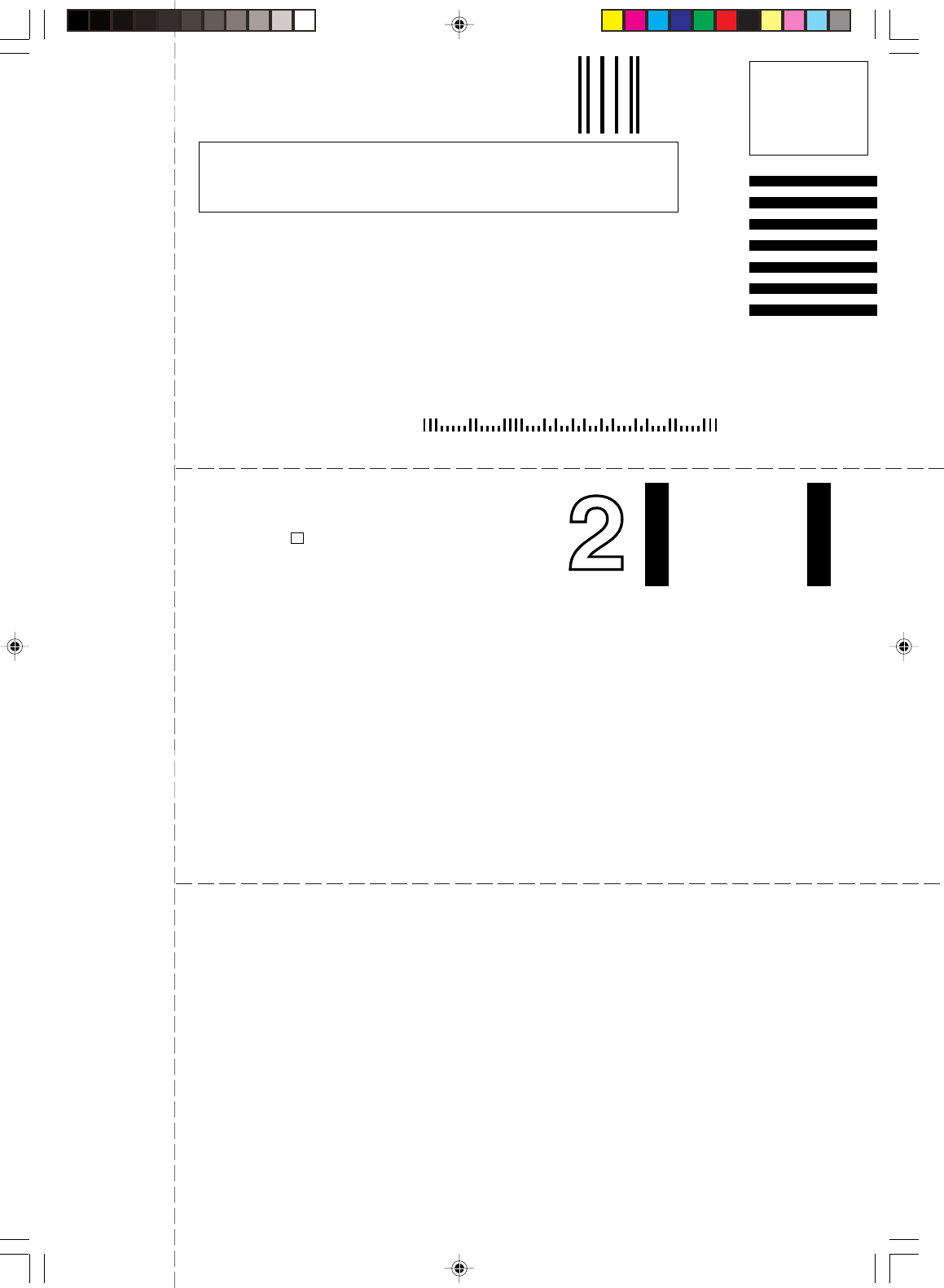
Attn: Warranty Department
Raytheon Marine Company
Recreational Products
676 Island Pond Road
Manchester NH 03109-9953
USA
BUSINESS REPLY MAIL
FIRST CLASS MAIL PERMIT NO. 369 MANCHESTER NH
POSTAGE WILL BE PAID BY ADDRESSEE
NO POSTAGE
NECESSARY
IF MAILED
IN THE
UNITED STATES
Raytheon Marine Company
Recreational Products
Freepost PT 1127
Portsmouth
PO3 5BR
England
Note: This information is held by Raytheon Marine only
and shall not be made available to any other companies.
Raytheon Marine may send you mailshots/details of any
new products.
Please tick this box
❐
if you do not wish to receive any
further information from Raytheon Marine.
NO STAMP REQUIRED IF POSTED IN THE UK.
warranty.p65 24/12/98, 08:553

Purchased from
Dealer address
Installed by Installation date
Owner’s name
Mailing address
North and South America
Detach and mail this portion within 48 hours.48 hours.
48 hours.48 hours.
48 hours.
To validate the warranty, the customer or dealer must fill in
the requested information below and mail to address shown
on front.
Retain other portion for your records.
Commissioned by Commissioning date
Purchase date
Purchased from
Dealer address
Installed by Installation date
Owner’s name
Mailing address
UK, Europe, Middle East and Far East
Detach and mail this portion within 48 hours.48 hours.
48 hours.48 hours.
48 hours.
To validate the warranty, the customer or dealer must fill in
the requested information below and mail to address shown
on front.
Retain other portion for your records.
Commissioned by
Boat’s name/Boat type/Location
Commissioning date
Purchase date
Stick barcode label here
Stick barcode label here
Owner’s occupation
Boat’s name/Boat type/Location
Owner’s occupation
warranty.p65 24/12/98, 08:554

warranty.p65 24/12/98, 08:555